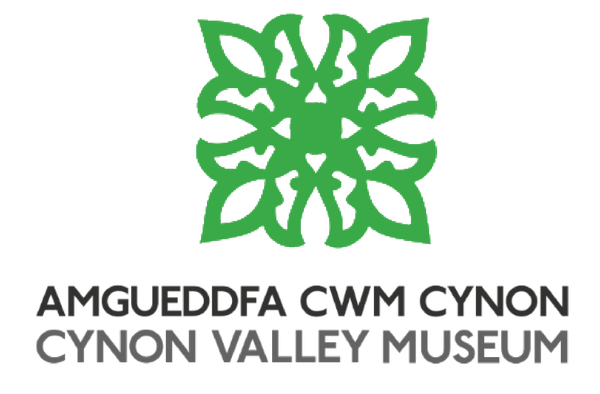The Work of Paul Peter Piech – a lesson for all
The museum boasts a large collection of linocut prints by artist Paul Peter Piech, including a small collection of ‘Racism is a Poison’ anti-racism series prints. A number of these prints were featured in an exhibition at the Museum in 2018.
This article will explore Piech’s work and life in Wales, and its impact on his art.
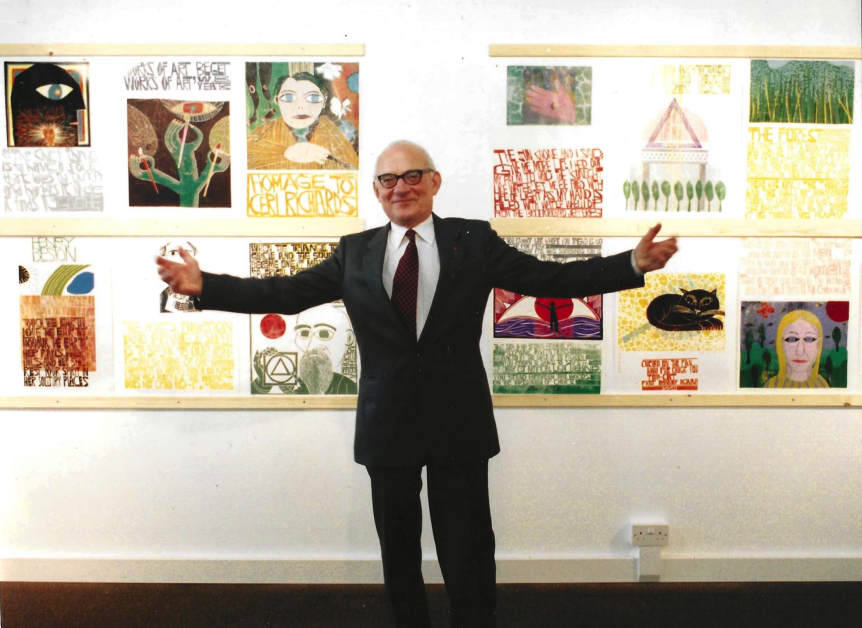
Paul Peter Piech standing in front of one of his exhibitions. Image owned and kindly provided by Olwen Stocker.
Piech’s daughter, Olwen, provided us with information about Piech’s family life:
‘My mother Irene Tomkins and her family were born and bred in Aberdare (Abercwmboi) and my grandfather was a coal miner there. Dad was an American printmaker who devoted 24/7 (including Christmas Day!) to his work and his beloved printing press, as he ate, slept and breathed his art every day.
Piech wasn’t necessarily interested in selling his works, as his priority was to get his message across to people, directly and with urgency.
He also taped a number of posters on certain issues up in bus shelters and other public places. His main concern was that people ‘get out of their apathy and think about the world.’
To make his art he would purchase the lino in 4 ft. wide rolls from a local flooring shop and then slash them into manageably sized rectangles with a Stanley knife. He would mark freehand guidelines (no ruler!) for the text with a white pencil, and then mark in rough outlines. He would then cut into the lino with a broad-headed engraving tool, turning the piece as he went.
The first proofs were made on his Thompson Gem press, whether it was day or night. The posters were then hung from a nylon washing line in the conservatory to dry.
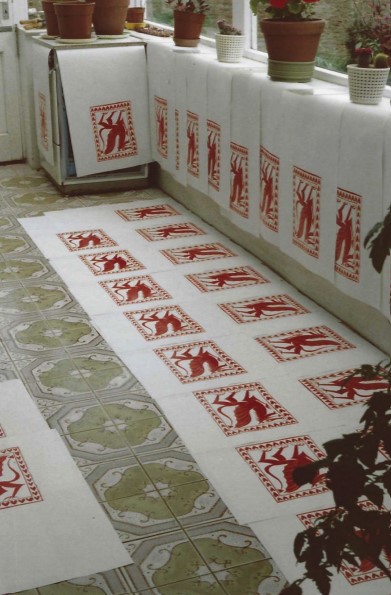
Piech’s welsh dragon prints, hanging to dry in the conservatory! Image owned and kindly provided by Olwen Stocker.
Piech taught at various art colleges as a part-time lecturer – Chelsea, Leicester, Hornsea, London School of Printing, Harrow and Watford.
He was never an active or paid-up member of any political party as such. When he was a boy/teenager, I believe his parents encouraged him to join the Young Communists’ Party in New York as they were from the Ukraine and found life in America very hard still. He always supported the ideals of the Labour Party, particularly in the 1950s and 1960s and in later years the Green Party. He also supported the ideals of Greenpeace for ecology and Amnesty International for peace and justice.’
Cynon Valley Museum also interviewed Jim Creed, former Coordinator of the Regional Print Centre and Memorial Gallery at Coleg Cambria in Wrexham, North Wales. Jim is very passionate and knowledgeable about the life and work of Piech, and we thank him for his wonderful contributions!
Q1. What do you know about Piech, his life, and how he came to live in Wales?
JC: Piech was born in New York in 1920 to Ukrainian immigrant parents and lived in a tough neighbourhood in Brooklyn. His parents’ strong work ethic combined with his huge sense of determination led to him being accepted to train at the Cooper Union for the Advancement of Science and Arts. Piech’s studies were suspended in 1942 due to the Second World War when he was enlisted into the US Eighth Army Air Force and posted in England. When on leave he visited Cardiff and met his future wife Irene Tompkins, who he later married in 1947. After the war, he studied printmaking at Chelsea College of Art under Ceri Richards and went on to work as a designer and illustrator in commercial advertising for firms such as Dorland Advertising Agency (UK and USA) and Crawford Advertising Agency in London.
In 1959 Piech set up his own private press called the Taurus Press and started to produce limited-edition artists books, leaflets, and portfolios. In the early 1970s, Piech left advertising and taught at various art schools across the UK (including London College of Printing and Leicester College of Art & Design) whilst creating and exhibiting vast numbers of political and socially motivated printed posters, many of which combined his trademark hard-hitting imagery with heavy cut linocut lettering.
Piech spent the last ten years of his life in Porthcawl, on the South Wales coast, where he and his wife Irene, originally from nearby Aberdare, had moved to retire. He made an influential impact on the Welsh art scene with his trademark heavy linocut lettering and socially motivated poster prints.
Q2. Can you explain Piech’s lino cutting technique? How he learned and developed it over time?
JC: Piech embraced life, notions of identity, and social issues throughout his artistic career. He used a range of printmaking techniques including lithography, woodcut, and wood engraving but his main printmaking process was linocut.
Most of his early printed books from the late 1950s/early 1960s were illustrated with woodblock or wood engravings combined with letterpress. Piech started using lino in the 1960s as it was cheaper, more portable, and readily available.
Piech’s linocut lettering isn’t perfectly aligned, spaced or sized, and varies wildly throughout his work and within individual pieces. His work is created with a sense of rapid energy. Often he wouldn’t draft the lettering out first and cut it without guide marks – the fact that it has to be cut back-to-front (because of the printing process) perhaps added to its individual style.
Piech mainly worked at home in his garage turned studio using a Thompson Proofing Press (which is still in use at Aberystwyth University) to produce his large broadsheet posters. He created every print himself and often hung them to dry in the conservatory or on the patio in the garden.
Q3. What motivated the different themes of Piech’s work?
JC: Piech’s work developed from an array of sources and covered a wide range of issues including power, racism, equality, torture, war, national identity, and politics. He was reflective and questioned the status quo, society, and politics using his artistic practice as a means to communicate his personal views and influences.
Piech’s prints quote from a variety of sources including William Blake, Martin Luther King, John F Kennedy, Jesus Christ, Margaret Thatcher, Adolf Hitler, Karl Marx and Mahatma Gandhi. They also cover a wide range of issues including power, racism, equality, torture, war, and national identity. He drew on both history and contemporary news. But Piech’s softer side is seen in his later prints which reflect his passion for jazz, literate, and poetry: his work includes references to William Shakespeare and the Welsh poets Hari Webb and RS Thomas.
Piech was sensitive to and influenced by everything around him: art, society, music, literature, politics, and his own life experiences past and present.

‘The History of Jazz can be told in four words: Louis Armstrong, Charlie Parker, Mile Davis’ Copy of an object held in CVM collection. This print can be found in our Jazz Band display case at the museum.
Q4. There’s not much information to be found on the ‘Racism is A Poison’ series. Do you know if it was a small collection?
JC: I believe there are six prints in the ‘Racism is A Poison’ series.
- Racism is a Poison – Remember the U.S.A in the 1920s
- Racism is a Poison – Remember Auschwitz
- Racism is a Poison – Remember Solingen
- Racism is a Poison – Remember Bosnia
- Racism is a Poison – Remember South Africa
- Racism is a Poison – Remember Soweto
I have had some amazing opportunities to develop projects and exhibitions featuring Piech’s (over the past 15 years) including co-curating a major retrospective of his work at the People’s History Museum in Manchester in 2016 that featured over 90 artworks included some of politically charged Piech prints and books from my own collection. This exhibition also featured the ‘Racism is a Poison’ series on loan from the Regional Print Centre in Wrexham, where I worked at the time.
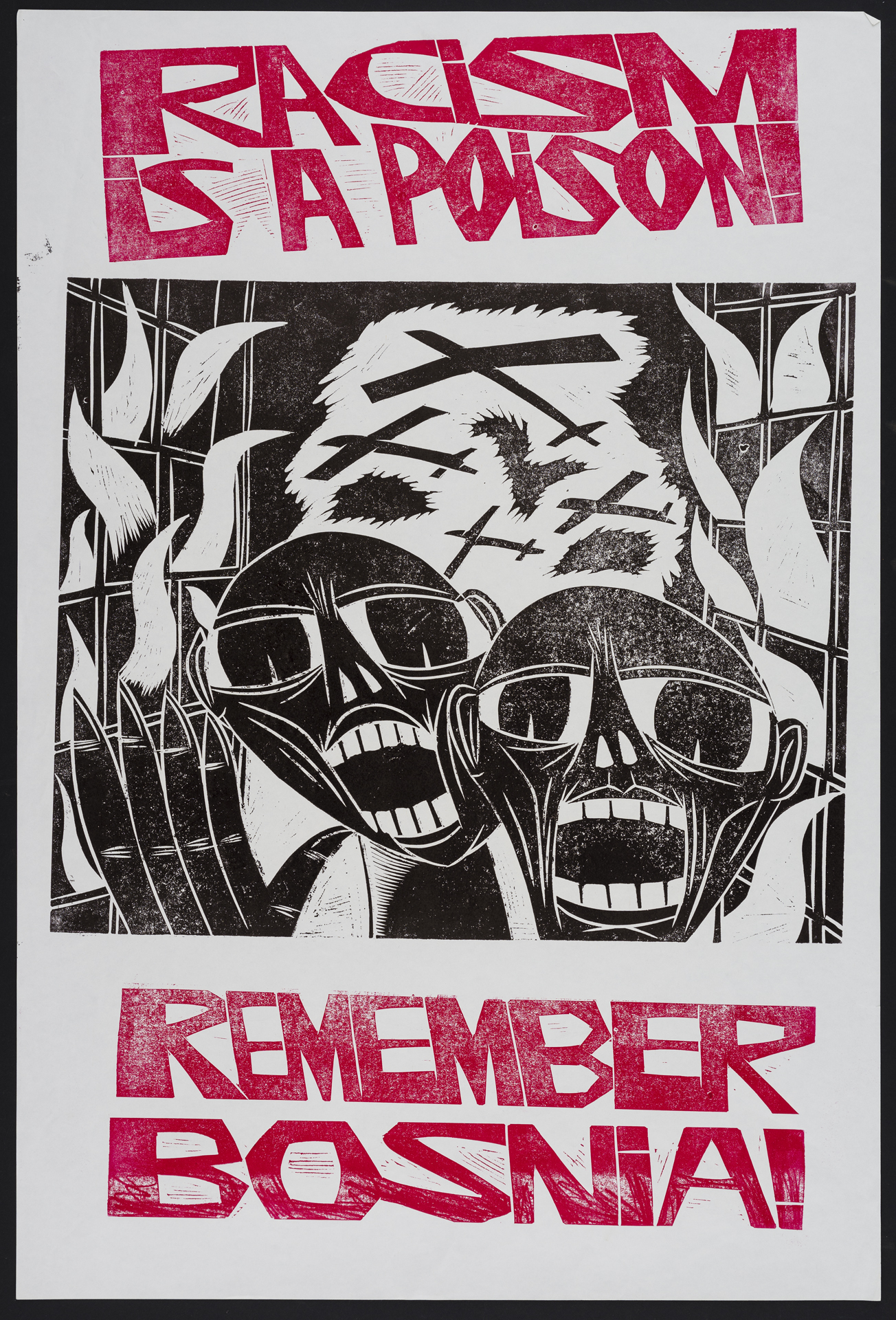
ACVMS 1997.3797 Racism is a Poison print, belonging to the CVM collection.

ACVMS 1997.3799 Racism is a Poison print, belonging to the CVM collection.
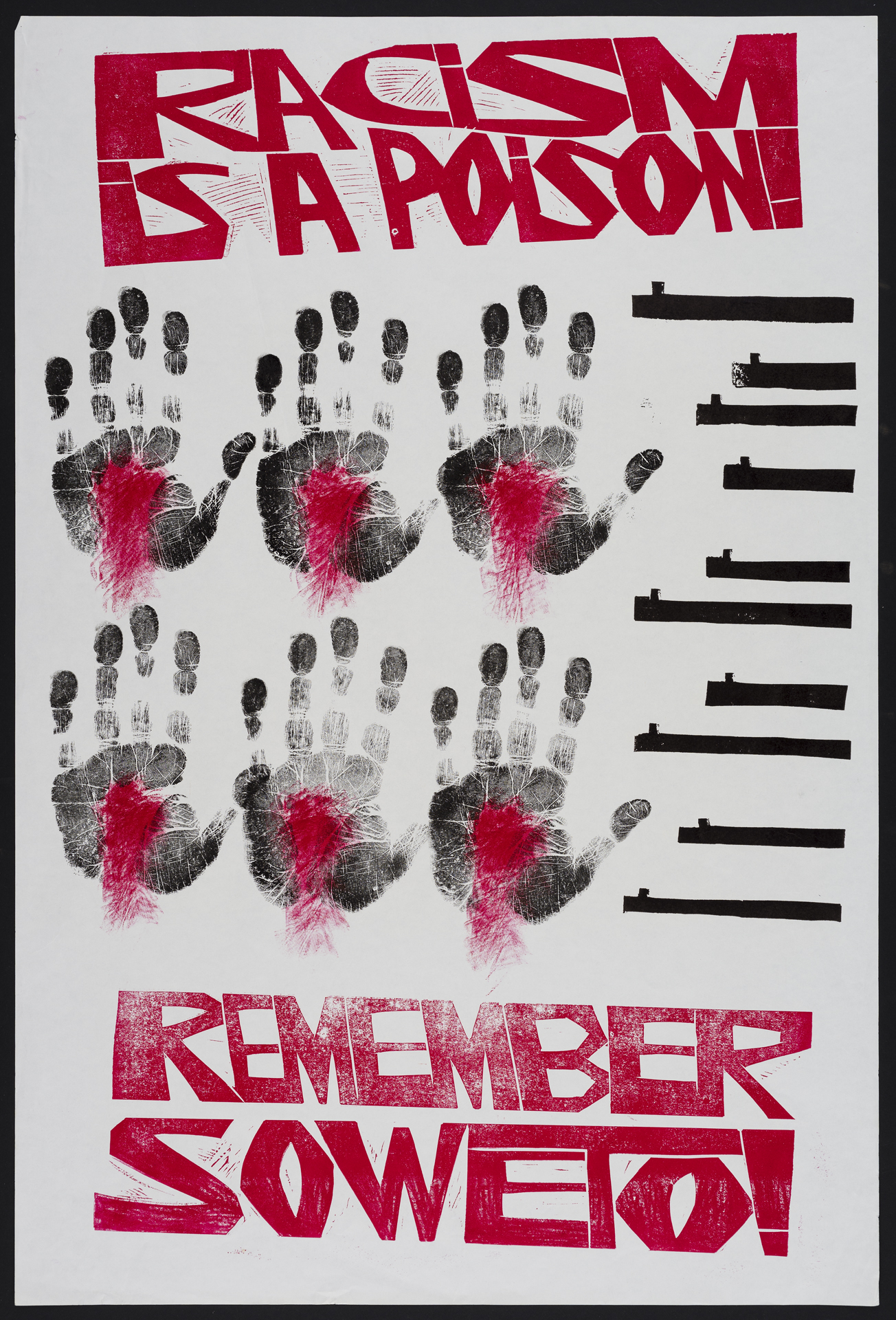
ACVMS 1997.3800 Racism is a Poison print, belonging to the CVM collection.

ACVMS 1997.3801_001 Racism is a Poison print, belonging to the CVM collection.
Q5. What year would this collection have been created/published?
JC: According to the fabulous book ‘The Graphic Work of Paul Peter Piech’ by Zoe Whitley, they were probably created and printed around 1995.
Q6. Would these have just been sold as artwork or were they also used as street art or protest posters etc?
JC: In most cases Piech’s prints were probably displayed unframed – on the reverse you may find stains/marks where the prints were ‘stuck’ to the wall – it could be blue-tac, tape and in some cases he used Velcro. His other favourite way of displaying prints was to pin them to the wall. This meant that pieces could be sold directly off the wall and replaced with another during an exhibition, and it also saved the cost and issues of transporting framed work. He could just arrive with a folder/tube of pieces. He wasn’t very precious about his prints – it was about the message and getting the work out there.
Some of Piech’s prints have edition numbers, while others do not, and several prints were on commercial papers, such as bright green and bright pink. This is down to a couple of reasons. Piech did produce prints in editions (sign/numbered/dates – mostly in editions of 25, 50, and some in 75). These were most likely for an exhibition or showcase where they would be sold. In some cases he was also commissioned by galleries/institutions to create editions – for example, he created a series of editions on JFK, Martin Luther King, Whalt Whitmann, Jazz, poetry etc.
Outside of this, Piech was continuously making and experimenting with his prints and produced hundreds (if not thousands) of one-off pieces. I would say that if it isn’t numbered it is most likely a one-off print. He also kept and reused most of his linocut printing plates to create other prints – many were one of a kind for a friend, or colleague, or for a commission.
He used very cheap paper to make his prints – most of which he would get for free. His use of commercial paper stems from this – using the bright vivid coloured paper was probably due to the fact it was freely available to him. Likewise, his use of Lino was also partly due to financial reasons – it was a lot cheaper and easier to cut than wood. I have an example of his prints on sugar paper (the type used in schools) and a version of an ‘Abolish Torture’ print brown parcel paper – whatever came to hand would be used. This links to the ethos behind the work and the notion that the political poster print was about the message and disposable (especially if it was stuck to a wall or lamppost).
Q7. Piech made many prints about Welsh linguists as well as coal miners. Would you say that he was inspired by the Welsh culture and experience?
JC: Piech embraced Welsh life, identity, and social issues, just as he had elsewhere throughout his life. His choice of literary quotations and focus on political and humanitarian issues continued to be part of his artistic palette even in retirement in South Wales. Cen Williams wrote that Piech ‘liked the Welsh because they were open people. His heart was also open to receive the traditions and values of his adopted country and to appreciate those things we believe are important to us.’
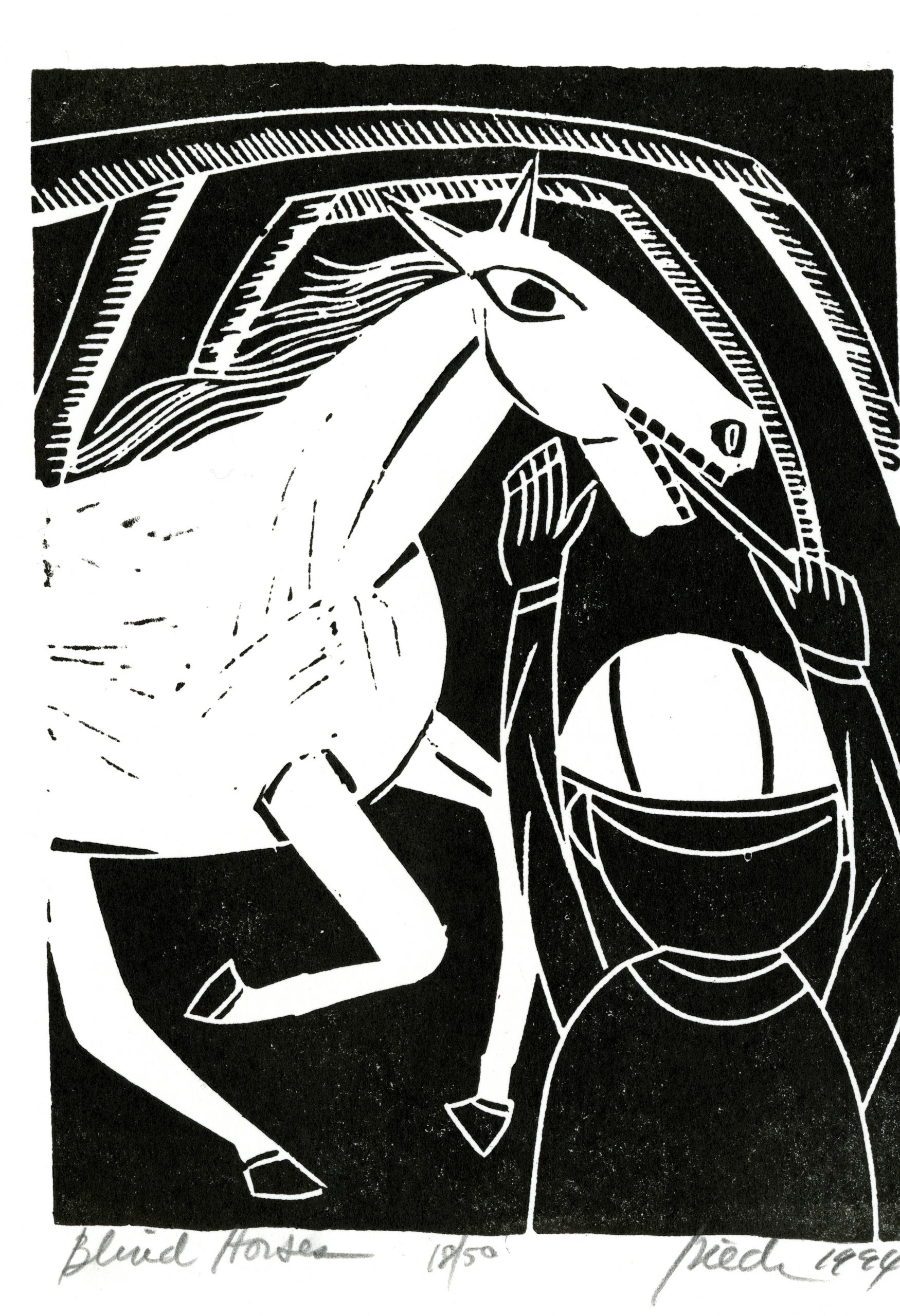
ACVMS 1997.3862_001 Piech print ‘Blind Horse’ 1994, belonging to the CVM collection.

ACVMS 1997.3862_001 Piech print ‘Pit Horse’ 1994 – belonging to the CVM collection.
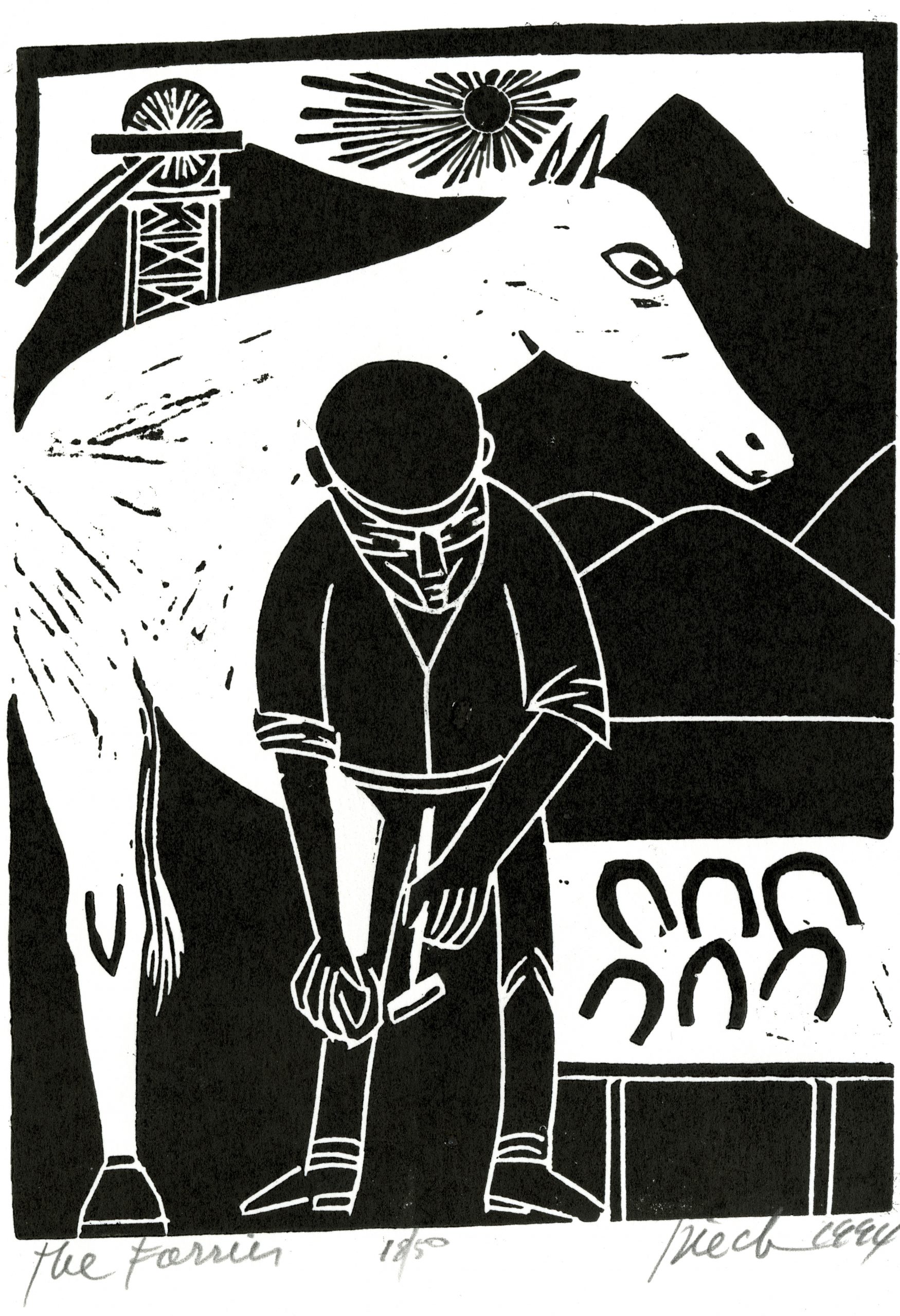
ACVMS 1997.3864_001 Piech print, 1994 – belonging to the CVM collection.
Q8. What is your favourite Piech print from your collection?
JC: As a self-confessed Piech obsessive, I have been collecting his work for about 15 years; it is really difficult to pick a favourite print from my collection (which is now made up of over 300 prints and artists books). However, I really love his prints that have a positive message, so I would say that the linocut print ‘Peace is just understanding people – helping them’ from 1982 is one of my favourites – the message is instantly visible, thought-provoking, and shows Piech’s true belief in peace and kindness.
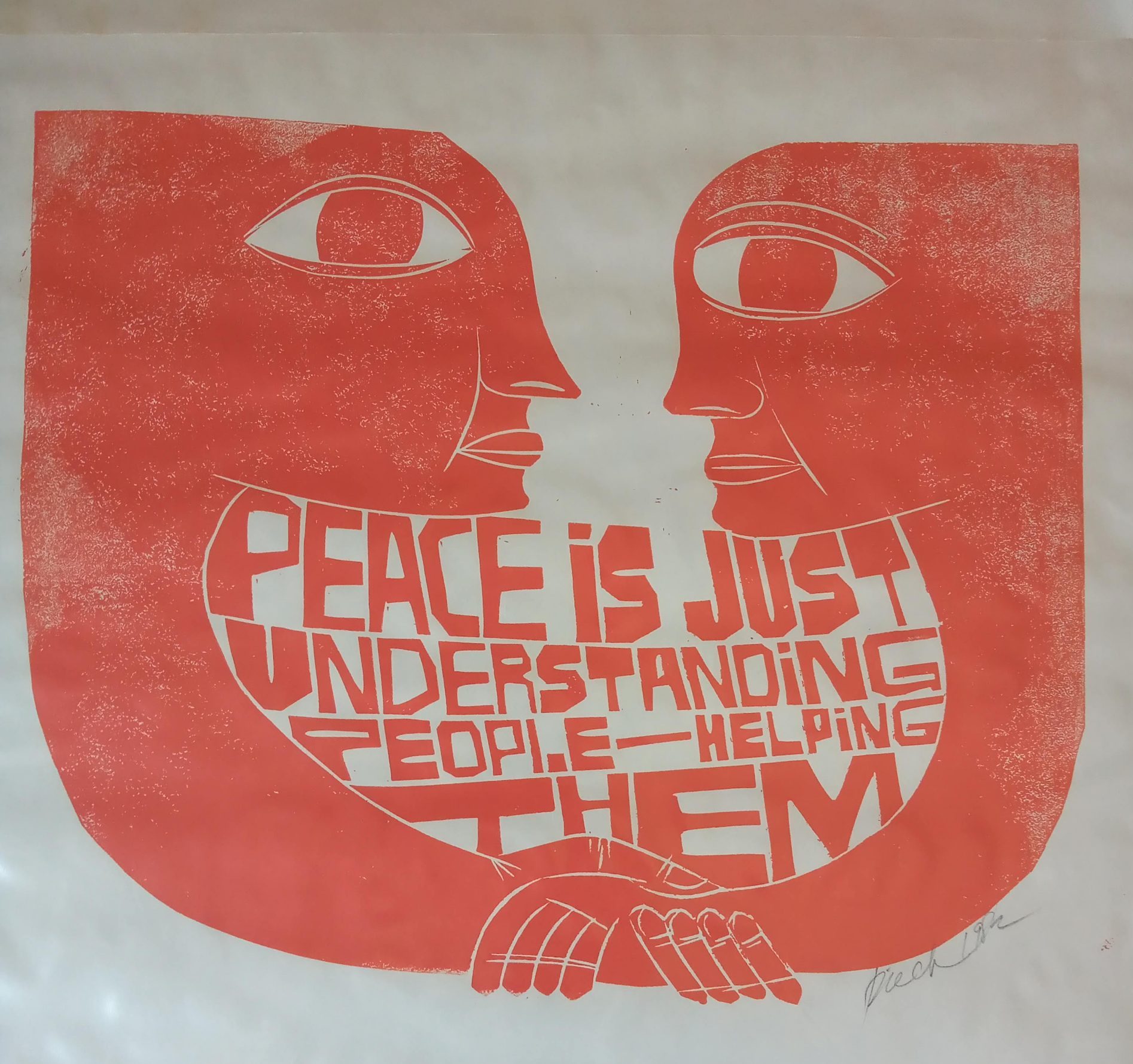
Piech, 1982 ‘Peace is just understanding people i.e. helping them’ Image owned and kindly provided by Jim Creed.

Piech print ‘Abolish Torture’ Image owned and kindly provided by Jim Creed.
Thank you very much again to Olwen Stocker and Jim Creed for assisting our research on Paul Peter Piech.
Have you heard of Paul Peter Piech? Do you recognise his work?
Get in contact with us, or comment below!
Sources and further reading:
- Williams, Cen, ‘a dream on the wall: the graphic work of Paul Peter Piech’, National Eisteddfod of Wales Bro Oger 1998, Art and Craft Exhibition Catalogue, p.41.
- Zoe Whitley ‘The Graphic Work of Paul Peter Piech’
- Jim Creed inPressing Matters magazine (2020) – download a free copy: https://www.pressingmattersmag.com/downloads
- Jim Creed interview for an exhibition project at FAU Galleries in America – https://www.youtube.com/watch?v=9XiQvg5oHLE
-
Exhibition link: https://www.fau.edu/artsandletters/galleries/exhibitions/ppp/
-
Creative Review article on the PPP exhibition in Manchester 2016/17 – https://www.creativereview.co.uk/paul-peter-piech-peoples-history-museum/
- People’s Collection Wales – Paul Peter Piech Collection – https://www.peoplescollection.wales/discover/query/paul%20peter%20piech
- https://www.palestineposterproject.org/special-collection/paul-peter-piech
